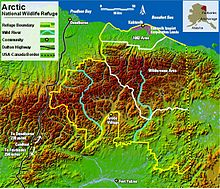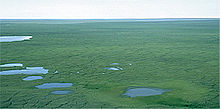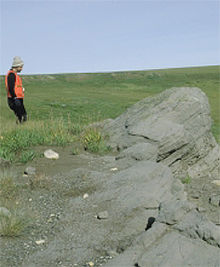- Arctic Refuge drilling controversy
-
The question of whether to drill for oil in the Arctic National Wildlife Refuge (ANWR) has been an ongoing political controversy in the United States since 1977.[1] The issue has been used by both Democrats and Republicans as a political device, especially through contentious election cycles, and has been the subject of much debate in the National media.[2]
ANWR comprises 19,000,000 acres (77,000 km2)[3] of the north Alaskan coast. The land is situated between the Beaufort Sea to the north, Brooks Range to the south, and Prudhoe Bay to the west. It is the largest protected wilderness in the United States and was created by Congress under the Alaska National Interest Lands Conservation Act of 1980.[4] Section 1002 of that act deferred a decision on the management of oil and gas exploration and development of 1,500,000 acres (6.1×109 m2) in the coastal plain, known as the "1002 area."[5] The controversy surrounds drilling for oil in this subsection of ANWR.
Much of the debate over whether to drill in the 1002 area of ANWR rests on the amount of economically recoverable oil, as it relates to world oil markets, weighed against the potential harm oil exploration might have upon the natural wildlife, in particular the calving ground of the Porcupine caribou.[6]
Contents
History
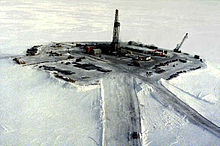 Mars Ice Island, a 60 day offshore exploratory well off Cape Halkett, over 30 miles (48 km) from Nuiqsut, Alaska.
Mars Ice Island, a 60 day offshore exploratory well off Cape Halkett, over 30 miles (48 km) from Nuiqsut, Alaska.
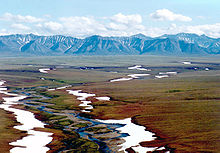 Area 1002 of the Arctic National Wildlife Refuge coastal plain, looking south toward the Brooks Range mountains.
Area 1002 of the Arctic National Wildlife Refuge coastal plain, looking south toward the Brooks Range mountains.
Before Alaska was granted statehood on January 3, 1959, virtually all 375,000,000 acres (1,520,000 km2) of the Territory of Alaska was federal land and wilderness. The act granting statehood gave Alaska the right to select 103,000,000 acres (420,000 km2) for use as an economic and tax base.[7] In 1966, Alaska Natives protested a Federal oil and gas lease sale of lands on the North Slope which were claimed by Natives. Late that year Secretary of the interior Stewart Udall ordered the lease sale suspended, and shortly thereafter announced a 'freeze' on the disposition of all Federal land in Alaska, pending Congressional settlement of Native land claims.[7][8] These claims were settled in 1971 by the Alaska Native Claims Settlement Act, which granted them 44,000,000 acres (180,000 km2). The act also froze development on federal lands pending a final selection of parks, monuments, and refuges. The law was set to expire in 1978.[9]
Toward the end of 1977, with the Trans-Alaska Pipeline System virtually complete, major conservation groups shifted their attention to how best to protect the hundreds of millions of acres of Alaskan wilderness unaffected by the pipeline.[10] On May 16, 1979, the United States House of Representatives approved a conservationist-backed bill that would have protected more than 125,000,000 acres (510,000 km2) of Federal lands in Alaska, including the calving ground of the nation's largest caribou herd. Backed by President Jimmy Carter, and sponsored by Morris K. Udall and John B. Anderson, the bill would have prohibited all commercial activity in 67,000,000 acres (270,000 km2) designated as wilderness areas. The US senate had opposed similar legislation in the past and filibusters were threatened.[11] On December 2, 1980, Carter signed into law the Alaska National Interest Lands Conservation Act, which created more than 104,000,000 acres (420,000 km2) of national parks, wildlife refuges and wilderness areas from Federal holdings in that state. The bill allowed drilling in ANWR, but not without prior approval from Congress. Both sides of the controversy announced they would attempt to change it in the next session of Congress.[12]
Section 1002 of the act stated that a comprehensive inventory of fish and wildlife resources would be conducted on 1,500,000 acres (6,100 km2) of the Arctic Refuge coastal plain (1002 Area). Potential petroleum reserves in the 1002 Area were to be evaluated from surface geological studies and seismic exploration surveys. No exploratory drilling was allowed. Results of these studies and recommendations for future management of the Arctic Refuge coastal plain were to be prepared in a report to Congress.
In November 1986, a draft report by the United States Fish and Wildlife Service recommended that all of the coastal plain within the Arctic National Wildlife Refuge be opened for oil and gas development. It also proposed to trade the mineral rights of 166,000 acres (670 km2) in the refuge for surface rights to 896,000 acres (3,630 km2) owned by corporations of six Alaska native groups, including Aleuts, Eskimos and Tlingits. The report argued that the oil and gas potentials of the coastal plain were needed for the country's economy and national security. Conservationists argued that oil development would unnecessarily threaten the existence of the Porcupine caribou by cutting off the herd from calving areas. They also expressed concerns that oil operations would erode the fragile ecological systems that support wildlife on the tundra of the Arctic plain. The proposal faced stiff opposition in the House of Representatives. Morris Udall, chairman of the House Interior Committee, said he would reintroduce legislation to turn the entire coastal plain into a wilderness area, effectively giving the refuge permanent protection from development.[13]
On July 17, 1987 the United States and the Canadian government signed the "Agreement on the Conservation of the Porcupine Caribou Herd"[14] a treaty which was designed to protect the species from damage to its habitat and migration routes. Canada has special interest in the region because its Ivvavik National Park and Vuntut National Park borders the refuge. The treaty required an impact assessment and required that where activity in one country is "likely to cause significant long-term adverse impact on the Porcupine Caribou Herd or its habitat, the other Party will be notified and given an opportunity to consult prior to final decision."[14]
In March 1989 a bill permitting drilling in the reserve was "sailing through the Senate and had been expected to come up for a vote"[15] when the Exxon Valdez oil spill delayed and ultimately derailed the process.[16]
In 1996 the Republican-majority House and Senate voted to allow drilling in ANWR, but this legislation was vetoed by President Bill Clinton. Toward the end of his presidential term environmentalists pressed Clinton to declare the Arctic Refuge a U.S. National Monument. Doing so would have permanently closed the area to oil exploration. While Clinton did create several refuge monuments, the Arctic Refuge was not among them.
A 1998 report by the U.S. Geological Survey estimated that there was between 5.7 billion barrels (910,000,000 m3) and 16.0 billion barrels (2.54×109 m3) of technically recoverable oil in the designated 1002 area, and that most of the oil would be found west of the Marsh Creek anticline.[17] When Non-Federal and Native areas are excluded, the estimated amounts of technically recoverable oil are reduced to 4.3 billion barrels (680,000,000 m3) and 11.8 billion barrels (1.88×109 m3). These figures differed from an earlier 1987 USGS report which estimated less quantities of oil and that it would be found in the southern and eastern parts of the 1002 area. However the 1998 report warned that the "estimates cannot be compared directly because different methods were used in preparing those parts of the 1987 Report to Congress."[18]
In the 2000s, votes about the status of the refuge occurred repeatedly in the U.S. House of Representatives and Senate. President George W. Bush pushed to perform exploratory drilling for crude oil and natural gas in and around the refuge. The House of Representatives voted in mid-2000 to allow drilling. In April 2002 the Senate rejected it.
Arctic Refuge drilling was again approved by the Republican-controlled House of Representatives as part of the Energy Bill on April 21, 2005,[19] but the Arctic Refuge provision was later removed by the House-Senate conference committee. The Republican-controlled Senate passed Arctic Refuge drilling on March 16, 2005 as part of the federal budget resolution for fiscal year 2006.[20] That Arctic Refuge provision was removed during the reconciliation process, due to Democrats in the House of Representatives who signed a letter stating they would oppose any version of the budget that had Arctic Refuge drilling in it.[21]
On December 15, 2005 Senator Ted Stevens, a Republican from Alaska, attached an Arctic Refuge drilling amendment to the annual defense appropriations bill. A group of Democratic Senators led a successful filibuster of the bill on December 21, and the language was subsequently removed.[22]
On June 18, 2008 President George W. Bush pressed Congress to reverse the ban on offshore drilling in the Arctic National Wildlife Refuge in addition to approving the extraction of oil from shale on federal lands. Despite his previous stance on the issue, President Bush cited the growing energy crisis as a major factor for reversing the presidential executive order issued by President George H. W. Bush in 1990, which banned coastal oil exploration and oil and gas leasing on most of the outer continental shelf. In conjunction with the presidential order, the Congressional moratorium banning drilling was first enacted in 1982 and has been renewed annually.[23]
Department of Energy projections and estimates
Estimates of oil reserves
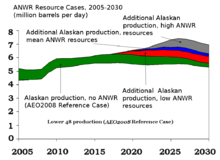 Projected levels of increased oil production from ANWR to mean Alaskan production volumes. Energy Information Administration, 2008.
Projected levels of increased oil production from ANWR to mean Alaskan production volumes. Energy Information Administration, 2008.
In 1998, the USGS estimated that between 5.7 and 16.0 billion barrels (2.54×109 m3) of technically recoverable crude oil and natural gas liquids are in the coastal plain area of ANWR, with a mean estimate of 10.4 billion barrels (1.65×109 m3), of which 7.7 billion barrels (1.22×109 m3) lie within the Federal portion of the ANWR 1002 Area.[17] In comparison, the estimated volume of undiscovered, technically recoverable oil in the rest of the United States is about 120 billion barrels (1.9×1010 m3).[24] The ANWR and undiscovered estimates are categorized as prospective resources and therefore, not proved. The United States Department of Energy (DOE) reports US proved reserves are roughly 29 billion barrels (4.6×109 m3) of crude and natural gas liquids, of which 21 billion barrels (3.3×109 m3) are crude.[25] A variety of sources compiled by the DOE estimate world proved oil and gas condensate reserves to range from 1.1 to 1.3 trillion barrels (210 km3).[26]
The DOE reports there is uncertainty about the underlying resource base in ANWR. “The USGS oil resource estimates are based largely on the oil productivity of geologic formations that exist in the neighboring State lands and which continue into ANWR. Consequently, there is considerable uncertainty regarding both the size and quality of the oil resources that exist in ANWR. Thus, the potential ultimate oil recovery and potential yearly production are highly uncertain.” [24]
In 2010, the USGS revised an estimate of the oil in the National Petroleum Reserve–Alaska (NPRA), concluding that it contained approximately "896 million barrels of conventional, undiscovered oil".[27] The NPRA is west of ANWR. The reason for the decrease is because of new exploratory drilling, which showed that many areas that were believed to hold oil actually hold natural gas.
The opening of the ANWR 1002 Area to oil and natural gas development is projected to increase domestic crude oil production starting in 2018. In the mean ANWR oil resource case, additional oil production resulting from the opening of ANWR reaches 780,000 barrels per day (124,000 m3/d) in 2027 and then declines to 710,000 barrels per day (113,000 m3/d) in 2030. In the low and high ANWR oil resource cases, additional oil production resulting from the opening of ANWR peaks in 2028 at 510,000 and 1.45 million barrels per day (231,000 m3/d), respectively. Between 2018 and 2030, cumulative additional oil production is 2.6 billion barrels (410,000,000 m3) for the mean oil resource case, while the low and high resource cases project a cumulative additional oil production of 1.9 and 4.3 billion barrels (680,000,000 m3), respectively.[24] In 2007, the United States consumed 20.68 m bbls of petroleum products per day. It produced roughly 5 million barrels per day (790,000 m3/d) of crude oil, and imported 10 million barrels per day (1,600,000 m3/d) of crude and 3.5 million barrels per day (560,000 m3/d) of petroleum products.[28]
Projected impact on global price
The total production from ANWR would be between 0.4 and 1.2 percent of total world oil consumption in 2030. Consequently, ANWR oil production is not projected to have a large impact on world oil prices.[24] Furthermore, the Energy Information Administration does not feel ANWR will affect the global price of oil when past behaviors of the oil market are considered. "The opening of ANWR is projected to have its largest oil price reduction impacts as follows: a reduction in low-sulfur, light crude oil prices of $0.41 per barrel (2006 dollars) in 2026 for the low oil resource case, $0.75 per barrel in 2025 for the mean oil resource case, and $1.44 per barrel in 2027 for the high oil resource case, relative to the reference case."[24] "Assuming that world oil markets continue to work as they do today, the Organization of Petroleum Exporting Countries (OPEC) could neutralize any potential price impact of ANWR oil production by reducing its oil exports by an equal amount."[24]
Opposing views
President Barack Obama opposes drilling in the Arctic Refuge.[29] In a League of Conservation Voters questionnaire, Obama said, "I strongly reject drilling in the Arctic National Wildlife Refuge because it would irreversibly damage a protected national wildlife refuge without creating sufficient oil supplies to meaningfully affect the global market price or have a discernible impact on US energy security." Senator John McCain, while running for the 2008 Republican presidential nomination, said, "As far as ANWR is concerned, I don't want to drill in the Grand Canyon, and I don't want to drill in the Everglades. This is one of the most pristine and beautiful parts of the world."[30]
In 2008, the U.S. Department of Energy reported uncertainties about the USGS oil estimates for ANWR and the projected effects on oil price and supplies. "There is little direct knowledge regarding the petroleum geology of the ANWR region.... ANWR oil production is not projected to have a large impact on world oil prices.... Additional oil production resulting from the opening of ANWR would be only a small portion of total world oil production, and would likely be offset in part by somewhat lower production outside the United States."[24]
The DOE reported that annual United States consumption of crude oil and petroleum products was 7.55 billion barrels (1.200×109 m3) in 2006 and again in 2007, totaling 15.1 billion barrels (2.40×109 m3).[31] In comparison, the USGS estimated that the ANWR reserve contains 10.4 billion barrels (1.65×109 m3). Although, only 7.7 billion barrels (1.22×109 m3) were thought to be within the proposed drilling region.[17]
"Environmentalists and most congressional Democrats have resisted drilling in the area because the required network of oil platforms, pipelines, roads and support facilities, not to mention the threat of foul spills, would play havoc on wildlife. The coastal plain, for example, is a calving home for some 129,000 caribou." [2]
The NRDC argues that drilling would not take place in a compact, 2,000-acre (8.1 km2) space as proponents claim, but in fact, undertake "a spiderweb of industrial sprawl across the whole of the refuge's 1,500,000-acre (6,100 km2) coastal plain, including drill sites, airports and roads, and gravel mines, it would have a footprint of 12,000 acres (49 km2), but actually spread across an area of more than 640,000 acres (2,600 km2), or 1,000 square miles (2,600 km2). Additionally, drilling opponents warn of the danger of oil spills in the region.[32][33]
The US Fish and Wildlife Service has stated that the 1002 area has a "greater degree of ecological diversity than any other similar sized area of Alaska's north slope." The FWS also states, "Those who campaigned to establish the Arctic Refuge recognized its wild qualities and the significance of these spatial relationships. Here lies an unusually diverse assemblage of large animals and smaller, less-appreciated life forms, tied to their physical environments and to each other by natural, undisturbed ecological and evolutionary processes."[34]
Prior to 2008, 39% of the residents of the United States[35] and a majority of Canadians opposed drilling in the refuge.[36]
The Alaska Inter-Tribal Council, which represents 229 Native Alaskan tribes, officially opposes any development in ANWR.[37] In March 2005 Luci Beach,[38] the executive director of the steering committee for the Native Alaskan and Canadian Gwich’in tribe (a member of the AI-TC), during a trip to Washington D.C., while speaking for a unified group of 55 Alaskan and Canadian indigenous peoples, said that drilling in ANWR is "a human rights issue and it's a basic Aboriginal human rights issue."[39] She went on to say, "Sixty to 70 percent of our diet comes from the land and caribou is one of the primary animals that we depend on for sustenance." The Gwich'in tribe adamantly believes that drilling in ANWR would have serious negative effects on the calving grounds of the Porcupine Caribou herd that they partially rely on for food.[40]
A part of the Inupiat population of Kaktovik, and 5,000 to 7,000 Gwich’in peoples feel their lifestyle would be disrupted or destroyed by drilling.[41] The Inupiat from Point Hope, Alaska recently passed resolutions [42] recognizing that drilling in ANWR would allow resource exploitation in other wilderness areas. The Inupiat, Gwitch'in, and other tribes are calling for sustainable energy practices and policies. The Tanana Chiefs Conference (representing 42 Alaska Native villages from 37 tribes) opposes drilling, as do at least 90 Native American tribes. The National Congress of American Indians (representing 250 tribes), the Native American Rights Fund as well as some Canadian tribes also oppose drilling in the 1002 area.
In May 2006 a resolution was passed in the village of Kaktovik calling Shell Oil Company "a hostile and dangerous force" which authorized the mayor to take legal and other actions necessary to "defend the community."[43] The resolution also calls on all North Slope communities to oppose Shell owned offshore leases unrelated to the ANWR controversy until the company becomes more respectful of the people.[44] Mayor Sonsalla says Shell has failed to work with the villagers on how the company would protect bowhead whales which are part of Native culture, subsistence life, and diet.[44]
See also
- National Petroleum Reserve–Alaska
- Oil on Ice and Being Caribou, two documentary films about the Arctic Refuge drilling controversy.
- Arctic policy of the United States
References
- ^ Shogren, Elizabeth. "For 30 Years, a Political Battle Over Oil and ANWR." All Things Considered. NPR. 10 Nov. 2005.
- ^ a b Waller, Douglas. "Some Shaky Figures on ANWR Drilling." Time 13 Aug. 2001.
- ^ Burger, Joel. "Adequate science: Alaska's Arctic refuge." Conservation Biology 15 (2): 539.
- ^ United States. 96th Congress. "Alaska National Interest Lands Conservation Act." Fws.gov <http://alaska.fws.gov/asm/anilca/toc.html>. Retrieved on 2008-8-10.
- ^ "Potential Oil Production from the Coastal Plain of the Arctic National Wildlife Refuge: Updated Assessment". US DOE. http://www.eia.doe.gov/pub/oil_gas/petroleum/analysis_publications/arctic_national_wildlife_refuge/html/overview.html. Retrieved 2009-03-14.
- ^ Mitchell, John. "Oil Field or Sanctuary?" National Geographic 1 Aug. 2001.
- ^ a b Jones, R.S. (June 1, 1981). ALASKA NATIVE CLAIMS SETTLEMENT ACT OF 1971 (PUBLIC LAW 92-203):HISTORY AND ANALYSIS TOGETHER WITH SUBSEQUENT AMENDMENTS. Government Division.
- ^ "Alaskans Dispute 'Freeze' on Land; Udall in Controversy Over State's Choice of Acreage." New York Times 11 June 1967: 11.
- ^ Kovach, Bill. "Bill on Future of Federal Lands in Alaska Generates Bitter and Emotional Controversy." New York Times 19 June 1978: B4.
- ^ Rensberger, Boyce. "Protection of Alaska's Wilderness New Priority of Conservationists." New York Times 31 Oct. 1976.
- ^ "Alaskan Lands Bill Saing Vast Areas Approved by House." New York Times 17 May 1979: A1.
- ^ King, Seth. "Carter Signs a Bill to Protect 104000000 Million acres in Alaska." New York Times 3 Dec. 1980.
- ^ Shabecoff, Philip. "U.S. Proposing Drilling for Oil in Arctic Refuge." New York Times 25 Nov. 1986.
- ^ a b United Nations. Agreement Between the Government of the United States and the government of Canada on the Conservation of the Porcupine Caribou Herd New York: UNU. 1987.[1]
- ^ Dionne, E. J. Jr. "Big Oil Spill Leaves Its Mark On Politics of Environment." New York Times 3 Apr. 1989.
- ^ "Reaction to Alaska Spill Derails Bill to Allow Oil Drilling in Refuge." New York Times 12 Apr. 1989.
- ^ a b c United States Geological Survey. Arctic National Wildlife Refuge, 1002 Area, Petroleum Assessment 1998, Including Economic Analysis. USGS Fact Sheet FS-028-01, Apr. 2001.
- ^ 'United States Geological Survey. Arctic National Wildlife Refuge, 1002 Area, Petroleum Assessment 1998, Including Economic Analysis. USGS Fact Sheet FS-028-01, Apr. 2001, p. 6.
- ^ United States. House of Representatives. Bill Number H.R.6 for the 109th Congress. Washington, DC: Library of Congress. 2005.
- ^ United States. The Congressional Budget for the United States Government for Fiscal Year 2006. Washington, DC: GPO. 2006.
- ^ Taylor, Andrew. "House Drops Arctic Drilling From Bill." Washington Post 10 Nov. 2005.
- ^ Coile, Zachary. "Senate blocks oil drilling push for Arctic refuge." San Francisco Chronicle 22 Dec. 2005.
- ^ Stolbert, Sheryl. "Bush Calls for End to Ban on Offshore Oil Drilling." New York Times 19 June 2008.;P
- ^ a b c d e f g United States. Department of Energy. Energy Information Administration. Analysis of Crude Oil Production in the Arctic National Wildlife Refuge. SR/OIAF/2008-03. Washington, DC: GPO. 2008.
- ^ United States. Department of Energy. Energy Information Administration. U.S. Crude Oil, Natural Gas, and Natural Gas Liquids Reserves Report Washington, DC: GPO. 2007.
- ^ United States. Department of Energy. Energy Information Administration. "Table of World Proved Oil and Natural Gas Reserves." Doe.gov. Retrieved on 2008-8-10.
- ^ USGS Release: USGS Oil and Gas Resource Estimates Updated for the National Petroleum Reserve in Alaska (NPRA) (10/26/2010 12:43:17 PM). Usgs.gov. Retrieved on 2011-10-11.
- ^ United States. Department of Energy. Energy Information Administration. "Petroleum Basic you smell Statistics." Retrieved on 2008-8-10.
- ^ Kluger, Jeffrey. "Going Green: The Eco Vote." Time 2 Nov. 2007: 123.
- ^ Geraghty, Jim. "The Campaign Spot: John McCain interview." National Review 16 Jan. 2008.
- ^ United States. Department of Energy. Energy Information Administration. Petroleum and other liquids. Washington, DC: GPO. 2008.
- ^ Pierce, Melinda. "Drilling in the ANWR." Science Friday NPR. 2 Mar. 2001.
- ^ NRDC. "Drilling in the Arctic Refuge: The 2,000-Acre Footprint Myth."
- ^ United States. Fish and Wildlife Service. "Wild Lands: Ecological Regions with a focus on the Coastal Plain and Foothills." 14 Feb. 2006. Retrieved on 2008-8-01.
- ^ CNN. "CNN/Opinion Research Corporation Poll." Pollingreport.com 29 July 2006. Retrieved on 2008-8-01.
- ^ World Wildlife Fund, Canada. "Majority of Canadians Oppose Drilling in Arctic National Wildlife Refuge." 25 July 2005. Retrieved on 2008-8-01.
- ^ Alaska Inter-Tribal Council. "NCAI Resolution #BIS-02-056." 26 May 2005. Retrieved on 2008-8-01.
- ^ Wilderness Society. "Faces of Conservation." Wilderness.org. Retrieved on 2008-8-01.
- ^ "Gwich'in leader blasts Senate vote on ANWR drilling." Indianz.com 18 Mar. 2005. Retrieved on 2008-8-01.
- ^ Sands, Elizabeth and Stephanie Pahler. "Native Communities" Columbia University. Retrieved on 2008-8-01.
- ^ Gwich’in Steering Committee. "Gwichʼin Niintsyaa Resolution." 10 June 1988. Retrieved on 2008-8-01.
- ^ Episcopal Public Policy Network. "FACTS: Native Opposition to Drilling." Episcopalchurch.org 15 Sep. 2005. Retrieved on 2008-8-01.
- ^ "Kaktovik resolution blasts Shell Oil." Juneau Daily News 24 May 2006.
- ^ a b Ragsdale, Rose. "Kaktovik accuses Shell of insincerity." Petroleum News vol. 11 no. 21. 21 May 2006.
External links
- Official ANWR website, U.S. Fish and Wildlife Service
- Energy Information Administration Analysis of Crude Oil Production in the Arctic National Wildlife Refuge
- Pro-drilling advocacy organization, Arctic Power
- Sierra Club Map for Google Earth of the Proposed Drilling
- A meeting place for Alaska Advocates
- Oil on Ice, an award winning anti-drilling documentary
- Website of Arctic Slope Regional Corp, Regional Corporation of Alaska's North Slope Inupiat people
- Information and research site created by Alaska oil expert Richard Fineberg
- Alaska Inter-Tribal Council
- Canadian embassy website describing Canadian government's position opposing ANWR oil development
- BEING CARIBOU THE FILM
- USGS caribou research related to ANWR
- Anthropology and the ANWR drilling controversy
- Fact and Fiction about Gasoline Prices – Capitol Hill briefing by Jerry Taylor
- Energy Information Administration – Petroleum Basic Statistics
- CIA – The World Factbook
- Energy Information Administration – World Proved Reserves of Oil and Natural Gas
- International Monetary Fund – Oil Market Structure and High Prices
Coordinates: 69°52′27″N 144°09′55″W / 69.87417°N 144.16528°W
Peak Oil Core issues 
Results/responses Hirsch report · Oil Depletion Protocol · Price of petroleum · 2000s energy crisis · Energy crisis · Export Land Model · Food vs fuel · Oil reserves · Pickens Plan · Swing producer · Transition TownsPeople Books Films A Crude Awakening · Collapse · The End of Suburbia · Oil Factor · PetroApocalypse Now? · How Cuba Survived Peak Oil · What a Way to GoOrganizations Other "peaks" Energy in the United States Politics and law Energy Lobby · Energy policy · Energy Policy Act (1992 · 2005) · Offshore drilling debate · Oil politics · RPS · Secretary of Energy · New Energy For America · Energy law of the United StatesSources Material Solar by state Arizona · California · Hawaii · Nevada · New Jersey · New Mexico · OregonWind by state Environmental issues Organizations Categories:- Energy in the United States
- Environmental controversies
- Environment of Alaska
- National Wildlife Refuges in Alaska
- North Slope Borough, Alaska
- Petroleum in the United States
- Political controversies in the United States
- Industry in the Arctic
- Environmental issues in the United States
- Environmental issues with petroleum
- History of Alaska
Wikimedia Foundation. 2010.

